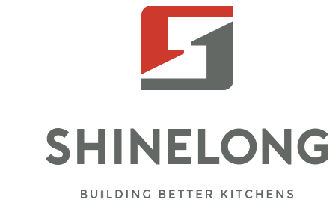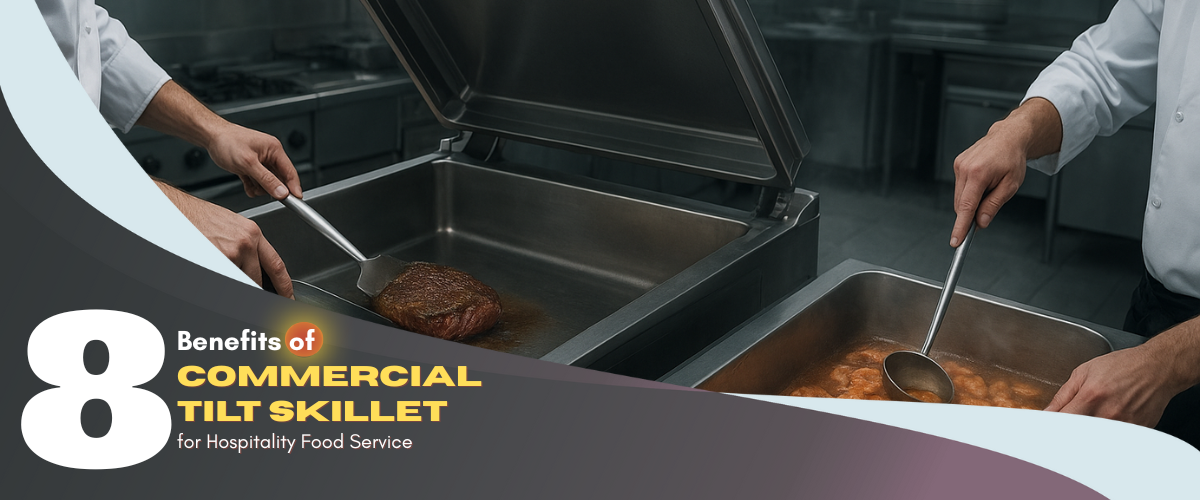News
8 Benefits of a Commercial Tilt Skillet for Hospitality Food Service
Is the commercial tilt skillet truly essential in a hospitality kitchen? Absolutely. It is one of the most multifunctional cooking appliances available, allowing chefs to boil, fry, deep-fry, sous vide cook, stew, and steam. It covers nearly every technique your menu requires and is a reliable asset for high-volume foodservice. Efficiency, safety, food quality, and 24/7 availability are critical considerations in hotel foodservice. Meeting this demand across all service points (café, dining hall, buffet, room service) within a limited space is the ultimate challenge. The braising pan provides the solution. SHINELONG will outline the 8 major benefits of the Commercial Tilt Skillet and demonstrate why it is an essential unit in the hotel kitchen equipment list.
The Primary Challenges the Hospitality Kitchen Is Facing
The hospitality industry is in constant motion, but three challenges never change: ① labor shortages, especially skilled labor, ② rising costs, and ③ maintaining consistent quality. In most hotel kitchens, these challenges hit hardest during events or 24/7 foodservice, when chefs must produce large quantities of food within narrow timeframes and limited staff. Traditional setups, using multiple stoves and ranges, consume space, time, and manpower.
The result? Overcrowded cooking lines, uneven heat distribution, and an exhausted crew trying to keep up with fluctuating demand. Many hotels are now turning to smarter, integrated cooking systems like the commercial tilt skillet to modernize operations and bring control back to the kitchen.

Tilting Fry Pan: The Versatile Solution for Busy Hotel Kitchens
What is the secret that allows the tilting skillet (AKA tilting fry pan) to optimise all professional kitchens? The perfect combination of several cooking systems and programmable cooking process, ready to braise beef, roast chicken, boil pasta, or reduce sauces any time, all with programmable precision. Below are the eight major advantages that make it indispensable in any hospitality kitchen.
1. Food Quality and Consistency
In large-scale production, achieving consistency across hundreds of portions is a chef’s biggest test. The Tilt Skillet offers a seamless, broad, uniform heating surface that ensures every batch cooks evenly, with no hot spots, no burned edges. This means the ingredient you put in the braising pan is not easily overcooked, which is really significant during busy food preparation. For hotels striving to maintain brand-level culinary standards across multiple outlets, this consistency is reputation insurance.
2. Precision Temperature Control & Nonstick Performance
Gone are the days of constant stirring or worrying about burning delicate sauces. A tilting fry pan offers precise digital temperature control, maintaining stability within a few degrees throughout the cooking cycle. This precision, combined with advanced nonstick or polished stainless-steel surfaces, prevents adhesion and scorching—even during extended braising or reduction cooking.
In short, you cook smarter, not harder.
3. Rapid Batch Cooking & Scalable Production
Speed is the foundation of profitability. With its large surface and efficient heat transfer, a commercial braising pan drastically reduces batch cooking time. You can sear meats, deglaze, and simmer sauces, all without transferring to another pot. Some hotel kitchens report up to a 35% faster turnaround compared to traditional stovetop setups.
When serving hundreds of covers daily, those minutes saved per batch add up to hours of reclaimed productivity.
4. Multi-Functional Cooking and Space Efficiency
Space is a luxury in professional kitchens, especially in urban hospitality environments. The Tilt Skillet acts as a fryer, griddle, stockpot, and holding tank, all within one compact footprint. A single unit can replace up to four traditional appliances, freeing valuable real estate for plating or prep areas.
In a kitchen where every square meter counts, multifunctionality is more than convenience; it’s strategy.
5. Cutting Operational Costs at Scale
Energy efficiency is one of the Tilt Skillet’s advantages. Because it retains heat effectively and minimizes preheat time, hotels often notice lower energy bills and reduced maintenance costs compared to using multiple smaller cookers. With most models featuring tilt-assisted draining and one-touch cleaning, water consumption also drops significantly.
Over time, the investment pays itself back, not just through efficiency, but through sustainability.
6. Labor Optimization & Time Management
Hotels today face growing pressure from labor shortages and rising wages. A smart commercial kitchen equipment like the Tilt Skillet reduces manual handling; ingredients are loaded, cooked, and poured out with minimal effort thanks to its tilting mechanism. One operator can handle large-volume batches safely and efficiently without additional manpower.
That means more output per chef, less fatigue, and smoother service during peak periods.
7. Hygiene and Cleaning Efficiency
Cleaning up after service is where most chefs lose time and patience. The Tilt Skillet’s smooth, welded corners and stainless interior simplify post-service hygiene. Constructed of premium stainless steel (usually SS 304), its smooth, flat surface is very easy to clean. The tilting function allows operators to directly rinse and discharge water into the floor drain or waste container, thereby achieving high-efficiency cleaning, helping maintain strict HACCP standards with minimal effort.
Tips: How to clean the tilt skillet properly
8. Smart Controls and Operator-Friendly Design
Modern hospitality kitchens are shifting toward automation, and Tilt Skillets fit perfectly into that ecosystem. Nowadays, commercial tilting skillets feature an intuitive operating interface and digital interface, allowing chefs to program and store specific cooking programs (recipes). This ensures that even inexperienced staff can execute complex multi-step recipes with push-button precision, significantly improving training efficiency and output consistency.
Some units even connect with smart monitoring systems to track energy use and cooking cycles, giving executive chefs better control over kitchen efficiency.
FAQs
Q1: What is a tilting fry pan in the kitchen?
A tilting fry pan, also known as a tilt skillet, is a professional kitchen equipment that is mostly used in commercial kitchens and hospitality foodservice. It uses contact heat and can steam, boil, braise or even stew. It is often used for high-volume cooking. The cooking system can be tilted to empty food for efficient transfer to containers.
Q2: Is it suitable for limited hospitality kitchens?
Absolutely. Compact models or floor models are available for boutique hotels and small restaurants. Even in limited spaces, the Tilt Skillet’s multifunctionality maximizes efficiency and production flow.
Q3: How do I maintain a Tilt Skillet?
Regular descaling, gentle cleaning after each use, and checking the tilting mechanism ensure longevity. Stainless steel interiors resist corrosion, making maintenance straightforward and cost-effective.
Q4: What dishes can I cook in it?
Anything from seared steaks and stir-fried noodles to stews, sauces, and pasta. Its versatility makes it one of the most valuable tools in any hospitality kitchen.
 After-Sales:
After-Sales:
 EN
EN
 AR
AR
 HR
HR
 NL
NL
 FI
FI
 FR
FR
 DE
DE
 EL
EL
 HI
HI
 IT
IT
 PT
PT
 RO
RO
 RU
RU
 ES
ES
 TL
TL
 ID
ID
 SL
SL
 VI
VI
 ET
ET
 MT
MT
 TH
TH
 FA
FA
 AF
AF
 MS
MS
 IS
IS
 MK
MK
 HY
HY
 AZ
AZ
 KA
KA
 UR
UR
 BN
BN
 BS
BS
 KM
KM
 LO
LO
 LA
LA
 MN
MN
 NE
NE
 MY
MY
 UZ
UZ
 KU
KU










